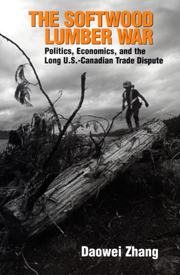|
The Softwood Lumber War
Politics, Economics, and the Long U.S.-Canadian Trade Dispute |
Daowei Zhang |
| |
|
"This
book will become the authoritative work. It brings the complicated and
intense political, legal, historical, and economic issues into an
easily understandable context. One has to appreciate the courage of the
author to tackle such a highly controversial, contentious, and
explosive subject as the lumber trade war."
--Stephen Devadoss, University of Idaho |
| |
|
"An
accurate, thorough, and comprehensive treatment of the long-running
trade conflict. Although there is a temporary resolution, the
disagreements between American and Canadian producers and consumers are
likely to resurface. This book provides insights into the dispute that
might help lead the various interests to a more permanent peace."
--Ross W. Gorte, Congressional Research Service
|
| |
"Daowei
Zhang cuts through the bombast on both sides and gets to the heart of
the dispute. This meticulously researched analysis should be required
reading for every Canadian and U.S. politician. Despite the 2006
agreement, the war is far from over."
--Don Whiteley, The Vancouver Sun
|

|
- Chapter 2: Theory of Economic Policy Formation
- Chapter 3: The First Shot
- Chapter 4: A New Coalition Emerges and the Signing of MOU
- Chapter 5: The U.S.-Canada Free Trade Agreement and the Withdrawal of MOU
- Chapter 8: Lumber IV: The Litigation Track
- Chapter 9: Lumber IV: The Negotiation Track
- Chapter 10: The Political Economy of the Lumber War: In Contrast with Newsprint
- Chapter 11: Tariff Battle
- Chapter 12: The Longevity of the Softwood Lumber Dispute: Where to Go From Chapter 1: Here and What Has Been Learned?
|
|
|
|
As
a forester interested in economics and policy, Daowei Zhang followed
the softwood lumber dispute between the U.S. and Canada for nearly 20
years. Dubbed the "Softwood Lumber War," the conflict enveloped
politicians and business leaders on both sides of the border and placed
strains on the historically close economic and political relations
between the two countries. This book is an unprecedented detailed
evaluation of how the conflict began and how it was sustained for such
a long period of time. The book considers the implications that may
follow from the 2006 agreement between the nations, and the broader
lessons that might be learned about international trade conflicts.
|
The
early 1980s was a difficult time for U.S. lumber producers. Finding
their domestic market share in decline, they requested restrictions on
Canadian lumber imports. Alleging that the Canadian producers were
being subsidized, they eventually secured a 15 percent export tax on
Canadian lumber in 1986. A long series of trade battles followed
against a background of shortages in the U.S. timber supply, changing
international markets, and the establishment of the North American Free
Trade Agreement and the World Trade Organization.
|
Canada
and the United States are the world's largest trading partners, but, as
Zhang demonstrates, it is a relationship in which domestic pressure
groups, different institutional structures within each government, and
differences in the relative economic power of each country remain
extremely important determinants of foreign policy. The fact that the
softwood lumber dispute has taken so long to resolve - and the prospect
that the 2006 agreement has the potential to be undone by continuing
litigation and trade friction - raise important questions about
international relations in a world that is supposedly moving toward
free trade.
|
|
|

|